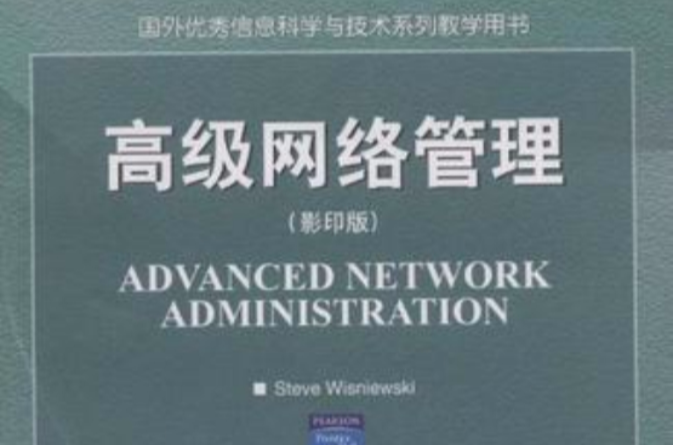作者簡介
Steve Wsniewski is currently working as a computer telephony engineer for Greenwich Technology Partners and has been in the internetworking and networking industry ofr more than 12 years.He is a 1972 Graduate of Marshall university,a 1995 graduate of De Vry Technical Institute,and has earned a master of science deree in telecommunications management from the Stevens Institute of Technology.
內容簡介
《高級網路管理(影印版)》由Steve Wisniewski著,Despite all the advances in technology,the old reliable architectures and protocolsare still being implemented in the internetworking arena today because they haveproven tO be reliable and have worked with many different products.Advanced Net-work Administration covers the concepts of routing,bridging,switching,and networkmanagement.This book iS recommended for novices who wish to further their knowl-edge ofinternetwork design.Chapters 1-3,OSI InternetworkingBasics,BridgingandSwitchingFundamentah,andRoutingBasics,shouldbetaughtas aunit.Chapters4 and5 cover Network ManagementFundamentals and Simple Network Management Proto-col.From Chapters 6 to 10,each of the main network architectures,along with thevarious protocols that comprise these architectures.are exposed.Chapters 11 and 12depart from the architectural viewpoint and discuss/nterdomain Routing Basics.OpenShortest Path First,explained in Chapter 11(OSPF),and Border Gateway Protocol,discussed in Chapter 12(BGP),are the main protocols being used in the Internet toprovide reliable routing from host to host.These two chapters should be tau#t as aunit.Chapter 1 3,Advanced IP Routing,provides a brief explanation of IP addressingand more advanced concepts such as VLSM andⅥANS,along with route summarization and redistribution.For a more thorough explanation on IP addressing refer toChapter 9,Digital Network Architecture(DNA)DEcnCt Phase IV.
Chapter 14 discusses Data Link Protocols and their importance in internet-working.Chapter 15,Internetworking Design Basics,is the capstone chapter dis-cussing how to design an internetwork using routmg and switching methods.
目錄
CHAPTER 1 Internetworking Basics 1
Introduction 2
What IS an Internetwork?3
The History of Internetworking 3
Internetworking Challenges 4
The Open System Interconnect (OSI) Reference ModeI 4
OSI lnformation Formats 12
The International Organization for Standardization (IOS)
Hierarchy of Networks 13
Connection Oriented and Connectionless Network Services 14
Internetwork Addressing 16
Comparing HierarchicaI and Flat Address Space 19
Flow Control,Error Checking,and Multiplexing 20
LacaI Area Networks:In.Depth Look 23
Wide Area Networks:An In-Depth Look 28
Summary 33
CHAPTER 2 Bridging and Switching Fundamentals 37
Introduction 3 8
Link Layer Devices:An Overview 39
Types of Bridges 40
Segmenting LANs 41
Why Segment LANs 41
Segmenting LANs Using Repeaters 42
Segmenting LANs Using Bridges 46
Segmenting LANs Using Switches 49
Bridging Technologies 53
Spanning Tree Algorithm(STA)67
What IS Spanning Tree ProtocoI and Why Use It 67
Summary 76
CHAPTER 3 Routing Basics 79
Introduction 80
Routing Components 80
Scaling Large Internetworks 80
Path Determination 83
Switching 84
Routing Algorithms 86
Distance Vector Routing Algorithms 90
Solutions 93
Implementing Solutions in Multiple Routes 97
Link State Routing Algorithms 98
Comparing Distance Vector Routing with Link State Routing 102
Network Layer ProtocoI Operations 104
Routing Metrics 107
Convergence Time 109
Congestion Overview 112
Traffic in an IP Network 112
Traffic in an IPX Network 113
Traffic in Other Multiprotocol Networks 113
Hybrid Routing 115
Snapshot Routing 117
Summary 119
CHAPTER 4 Network Management
Fundamentals 123
Introduction 124
Network Management Requirements 125
Background 126
OSI Management FunctionaI Areas 126
Network Management System(NMS)130
Network Management Configuration 130
Network Management Architecfure 132
Network Monitoring 136
Performance Monitoring 141
Fault Monitoring 148
Accounting Monitoring 150
Network Control 151
Configuration Control 151
Securitv Control 154
Security Management Functions 160
Summary 161
CHAPTER 5 Simple Network Management
Protocol 169
Introduction 170
TCP/IP 0rigins 170
TCP/IP and Network Management 171
Evolution Of SNMP 173
The SNMP Architecture 174
Trap-Directed Polling 178
Proxies 178
SNMP Management Information 179
SNMP and Abstract syntax NotatJon One(ASN.1) 183
ASN.1 Concepts 186
Basic Encoding Rules cBERl 192
Communities and Community Names 194
Lexicographic Ordering 200
SNMP Formats 201
Limitations of SNMP 210
Summary 211
CHAPTER 6 Systems Network Architecture 213
Introduction 214
Overview Of Corporate Networks 215
HierarchicaI Networks 215
Peer Networks 218
SNA Configuration 221
SNA Subarea Network 228
APPN Network 228
Foundation SNA Concepts 230
Network Components 231
Network Addressing 235
Routes 236
Class of Service Table 238
Layers 238
Sessions 240
Open Systems Interconnection and SNA 242
SNA Protocols 242
SNA/SDLC Frame Formats 245 IBM’S Advanced Communications Function/Virtual Communications Access Method(VTAM) 250
Network ControI Program(NCP) 252
Summary 253
CHAPTER 7 NetWare Protocols 255
Introduction 256
Concepts 257
Internet Packet Exchange(IPX) 258
IPX Routing Architecture 260
Routing Information ProtocoI (RIP) 271
SAP:Supporting Service Advertisements 277
Sequenced Packet Exchange (SPX)279
Sequenced Packet Exchange II (SPX II) 281
NetWare Core Protocol(NCP) 282
NetWare Link Service Protocol (NLSP) 286
RIP Problems 287
NLSP Messages 288
Summary 297
CHAPTER 8 AppleTalk Protocols 299
Introduction 300
AppleTalk and OSI 302
The Physical Layer-AppleTalk Hardware 303
Media Considerations for AppleTalk 306
Data Link Functions 306
Link Access ProtocollLAPl Manager for LocalTaIk 307
AppleTalk Addressing 311
AppleTalk Network Components 313
AppleTalk Phase I and Phase II 317
AppleTalk Address Resolution Protocol (AARP) 318
LSP Manager for EtherTalk and TokenTaIk 320
The AppleTalk Network Layer:Datagram Delivery Protocol (DDP) 326
Routing Table Maintenance Program ProtocoI (RTMP) 334
AppleTalk Echo Protocol (AEP) 340
Names on AppleToIk 340
Transport Layer Services:Reliable Delivery of Data 347
AppleTalk Transaction Protocol (ATP) 348
Printer Access Protocol (PAP) 349
AppleTalk Session Protocol (ASP) 350
AppleShare and the AppleTalk File Protocol(AFP)357
Summary 358

